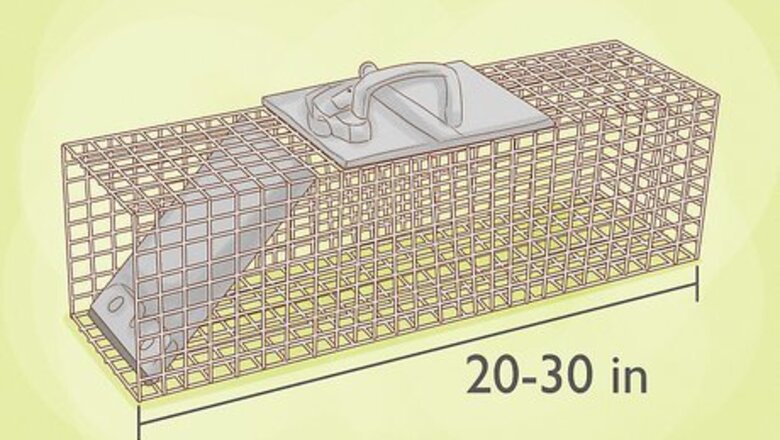
views
- Bait and set your trap in an area with high rabbit activity and make sure to check your trap often.
- Or, dig a hole, cover it with foliage and leaves, place bait on top of the cover, and wait for a rabbit to fall into your trap.
- Find copper wire, two sticks, and a bent tree to fashion your own rabbit snare.
Trapping a Rabbit in a Cage
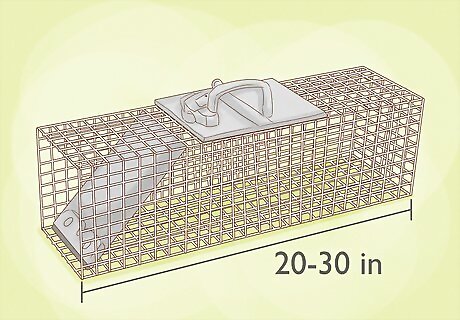
Choose a rabbit trap. These live rabbit traps consist of a cage with a trigger plate forces the door of the trap closed once the rabbit triggers the plate by entering into the cage. You can choose between one door or two door traps, but you'll want a trap that is 22 to 30 inches in length. You can often purchase these online or at an animal feed or hardware store or make your own rabbit trap. Havahart is a popular brand for rabbit traps. The one and two door traps are both effective traps, but have different benefits. The one door trap is favored by professional trappers and it allows you to place the rabbit bait behind the trigger plate, which lures the rabbit further into the cage. The two door trap allows the rabbit to enter the cage from both directions, thus providing a higher catch rate for rabbits. Rabbits will also become nervous or fearful once in the trap, but having a two door trap allows the rabbit to see through the trap, which can be comforting for the rabbit. The two door trap can also be set as a one door trap if desired.
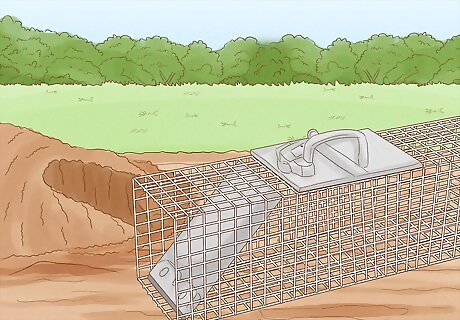
Pick a location for your trap. Determine where you have the most rabbit activity and place a trap along that area. Rabbits don't often cross stretches of land, so avoid placing a trap in an area that would require the rabbit to be vulnerable. You'll want to place your trap on a flat surface, placing a small weight on top of the trap so that other animals cannot tip it over to reach the bait. Rabbits are often in areas where they have cover and open land. Common areas rabbits are located are hedges, shrubs, trees, fence lines, tall grass, wood and brush piles, bushes, and tree lines. These are the locations you'll likely have the most success in catching a rabbit. If you are able to locate a rabbit's den or warren (rabbit hole), then place the trap a few feet from the entrance. You can often locate areas where rabbits have been by their droppings, which are dry, round pellets.

Place bait in trap. Choose a bait that is likely to attract rabbits and place bait behind trigger plate. In the winter, dried foods are better because they are less likely to freeze and in the summer, when food is abundant for rabbits, choosing richer fruits or vegetables, like apples and carrots, will be more effective in trapping a rabbit. If you are using a one door trap, place bait at the end of the cage, behind the trap opening. If you are using a two door trap, place bait between the two doors, in the center of the trap. Some baits to use for rabbits are fruits and vegetables like apple cores, bananas, potato peelings, lettuce leafs, raw cabbage, carrots, dandelions, and leafy weeds. If you find traditional baits aren't producing success, you can try using baits that are more unusual. Some ideas for these types of baits are cheesy biscuits crumbled up and peanut butter. Rabbits may be able to smell your scent on the trap and will avoid the trap because they feel that something is wrong. To cover up your scent, drip or spray apple cider onto the trap.

Set your trap. Now that you have placed your bait, it's time to set your trap. Follow the trap's instructions explaining how to set your trap. After you have set your trap, you'll want to check the trigger to make sure it is working properly. Gently press down on the trip plate, and the doors should immediately snap closed. If the rabbit you are trying to trap is on the smaller side, they may not be able to trip the trigger, so place a small weight on the trigger plate so that the combined weight of the two will be enough to make the trap effective. It could also be good to camouflage your trap with twigs and leaves, because a metal trap can produce a glare in the sun, causing the rabbit to avoid it.

Check your trap often. After you have set your trap, you'll want to check it often to see if you have caught a rabbit. If a rabbit is caught and you neglect your trap, the rabbit can quickly become malnourished, so you want to check the trap daily to prevent harming the rabbit. Keep in mind you may accidentally trap other animals in your trap. Raccoons are often lured into rabbit traps as well as other animals, so if you catch another animal release it immediately. You may find that you are not having much success with your trap if you are trying to catch a rabbit in the summer. That's because during the summer, rabbits often have a much higher supply of food and nutrients available to them. The best time to trap a rabbit is in the winter, when food is more scarce and the rabbit will be in search of food.

Be careful in handling the rabbit. If you have checked your trap and found a rabbit in it, be careful when removing the rabbit as it is probably scared and may bite you. Consider wearing gloves when removing the rabbit to prevent disease from spreading if it bites you, and approach it cautiously to prevent from frightening it even further. If you have caught a rabbit in hopes to keep it from destroying your garden or flowerbeds, then relocate the rabbit at least five miles away, if local law permits. Try placing the rabbit in a covered area, for extra protection.
Creating a Pit Trap
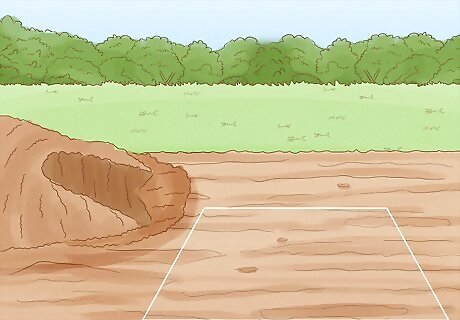
Find a location. A pit trap is probably one of the simplest forms of trapping a rabbit, as it just requires using the natural habitat of a rabbit, but it is probably one of the least successful. To begin this process, you'll want to find a good location to dig your pit. Look for signs of a rabbit, like a rabbit den or warren, rabbit droppings, or rabbit tracks.

Dig a hole. After you've found a good location for your pit, dig a hole that is deep enough that the rabbit won't be able to escape once it gets caught. A rabbit can jump approximately one meter high, or three feet, and three meters long, so it's best to build a hole that is very deep and narrow, making it difficult for the rabbit to jump out.
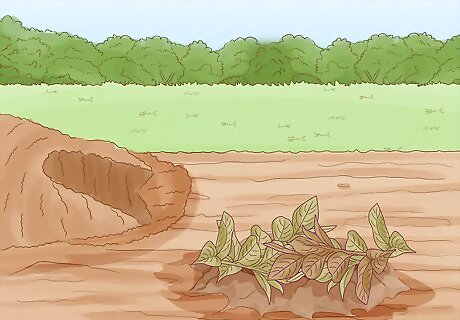
Cover the hole with twigs and leaves. In order to camouflage the hole, you'll need to place some twigs and leaves on top of it that blend in with the rest of the environment. Be careful not to put too much foliage on top of the hole so that it's sturdy enough for a rabbit to sit on. Use just the right amount of foliage that the rabbit believes it to be normal ground, but will fall through it if it sits on it. If you are unsure about the amount of foliage you have used, you can test out the trap by placing a five pound weight on top of it and see if the weight falls through. If it doesn't, then you have too much covering the hole and will need to remove some.

Place bait. After you have covered the hole adequately, you'll want to place bait on top of the hole to lure the rabbit in. You can use the same bait mentioned in the previous section -- foods like vegetables and fruits.

Check the trap regularly. Now that you've set the pit trap the only thing left is to check it daily, and once you've caught a rabbit, you can relocate it or kill it for food. The downside of this trap is it's easy to catch other animals in it, so when checking the trap, just be careful. You'll likely have some frightened animals inside of it that won't be afraid to bite you. As with the cage trap, use gloves and caution when handling wild animals. It's likely they'll try to bite you and they may carry diseases or have rabies.

Fill the hole back in. Once you have caught the rabbit, fill the pit you created back in with dirt or foliage. You don't want another animal falling in it and injuring themselves or becoming malnourished, so always cover up and remove any traps you have set once you are finished using them.
Making and Using a Snare
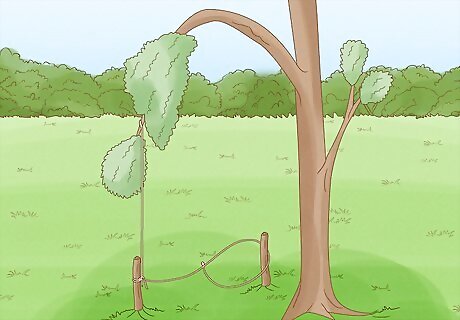
Understand a snare. Before you compose a snare, it's important to know that this mechanism does more than just trap a rabbit. If you are trying to trap a rabbit to relocate it, do not use a snare. A snare is essentially a noose mechanism that will kill a rabbit if it gets trapped and should only be used for hunting. Different states also have different laws about snares, so make sure you check your state's guidelines on hunting with snares.
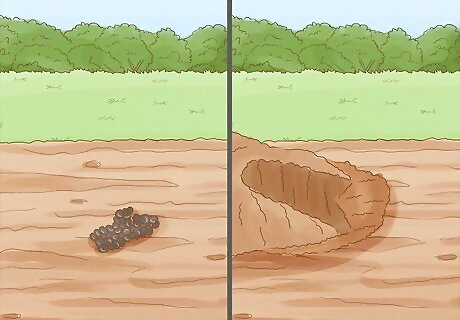
Look for signs of rabbits. Before you set a snare, you'll want to find a location that will give you the most success. A snare is best used in a more wilderness setting, like a forest where rabbits are frequent and the signs are easily identified. You can identify rabbits by their droppings (small, round, dry pellets), burrows, or tracks.
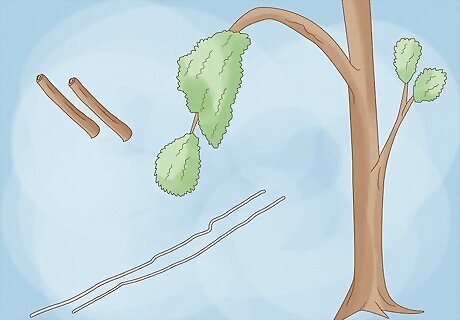
Gather your materials. To make a rabbit snare you will need wire (copper strands, picture hanging wire, or craft wire), wood or two sticks, and a tree that is bent. These materials will be used to create the noose, two part trigger, leader line, and engine, all of which are part of a Trigger Spring Snare. This specific type of snare is more advanced, so you may want to try a simple snare first. The noose is the part of the snare that will actually trap the animal. The two part trigger consists of a hook and a base. The base is a piece of wood, stuck in the ground that connects to the hook, which is what the noose is tied to. The leader line is a cord that is connected to the engine and the hook. The engine is usually a tree, like a bent over sapling or an extended branch, that provides tension to the hook and holds the snared animal. Essentially, the snare starts from the tree, which is bent over, and at the bent over part of the tree the leader line is connected, hanging down until it connects to the hook, which is a piece of wood that stands straight up and connects to the base, which is also straight up, but stuck in the ground. The noose then connects to the end of the hook.
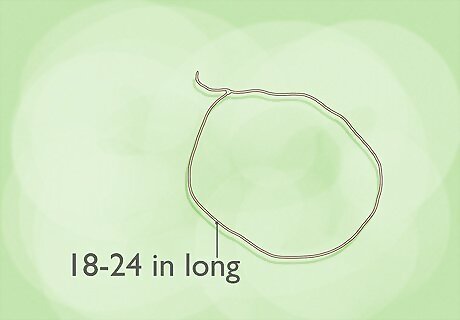
Create the noose. The length of the cord to create your noose needs to be about 18-24 inches long. First, begin by taking the end of your wire and create a loop, about the diameter of a pencil. You can take a pencil and wrap the wire around it, and then twist it together at the end to create your loop. Then, with the remaining wire, run a few inches of it through the loop, creating a noose. You'll connect the remaining end of the wire to the trigger.
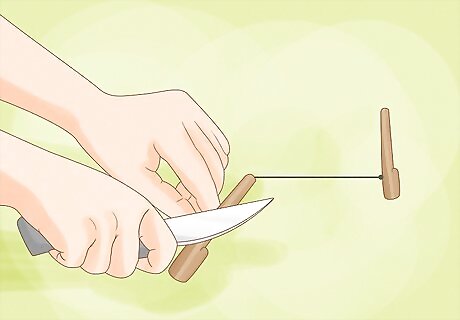
Create your base trigger. Your trigger is composed of two sticks or pieces of wood that are carved out to fit together. Taking a sturdy stick, make a straight carve, halfway into the stick, about an inch from the top of the stick. Then, carve down, parallel to the stick about an inch, and make another straight carve, from the middle of the stick to the outside of the stick. Carve out that piece of wood until you have a cavern in the wood that resembles a mouth.

Create your hook trigger. The hook trigger will be turned upside down, and slid into the base trigger. Taking your other piece of wood or stick, place it up to the mouth of the base stick, with the top of the hook stick at the bottom of the mouth. Then, mark a line where the top of the mouth of the base stick hits the hook stick. Carve a straight line about halfway into the stick, creating a pipe shape. Your hook should then fit into your base.
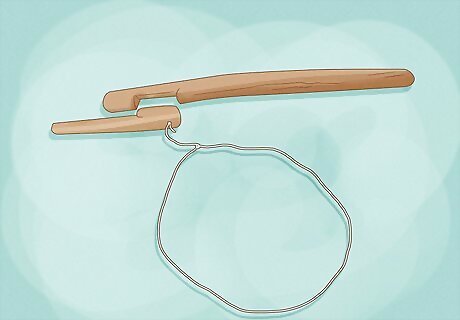
Connect the noose. Once you have created your trigger, stick the base into the ground until it feels sturdy, and then tie the loose end of your noose around the hook part of the trigger, right above where the hook fits into the base.

Connect the leader line. This line will be suspended from the "engine" connecting to the hook of the trigger. Tie the copper wire around the end of the hook, above where the noose is tied. Then, pull the line upwards to the end of your engine and connect it securely. When a rabbit enters the snare, the leader line and hook should pull away from the base, and the rabbit will be suspended from the tree. If you can't find a bent over tree, then you can connect your snare to a branch that is weighted down. The engine just needs to have some tension, so that it can withstand the initial spring jerk and it needs to be strong enough to suspend the animal in the air. Having a sturdy engine also leads to a more humane death, as the animal will die quickly, and it also prevents other predators from eating the rabbit.

Test out the snare. Before you set up the snare and wait to catch a rabbit, you'll want to test the snare by using a log (about five to eight pounds). Slide the log through the noose, making sure the hook and engine are working together to spring the noose into the air. If it seems to be working you're good to go!
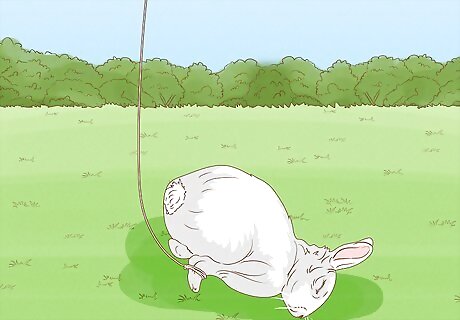
Check your snare frequently. Your snare needs to be checked several times a day if possible, so that you can collect your game before it starts to spoil and to prevent it from suffering longer. Once you have caught a rabbit, remove it and use as much of it as possible. The rabbit gave its life for you, so you don't want to waste it!




















Comments
0 comment